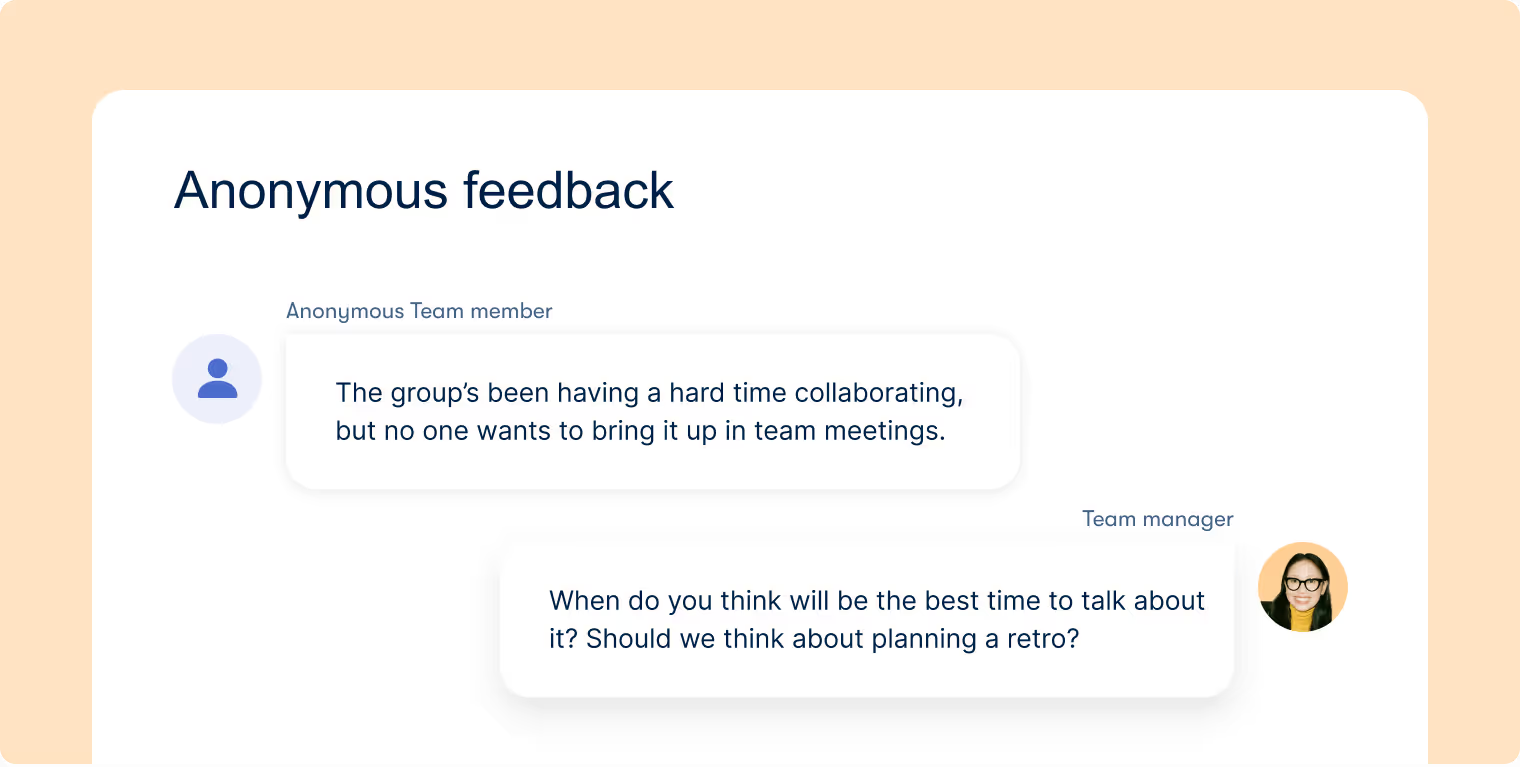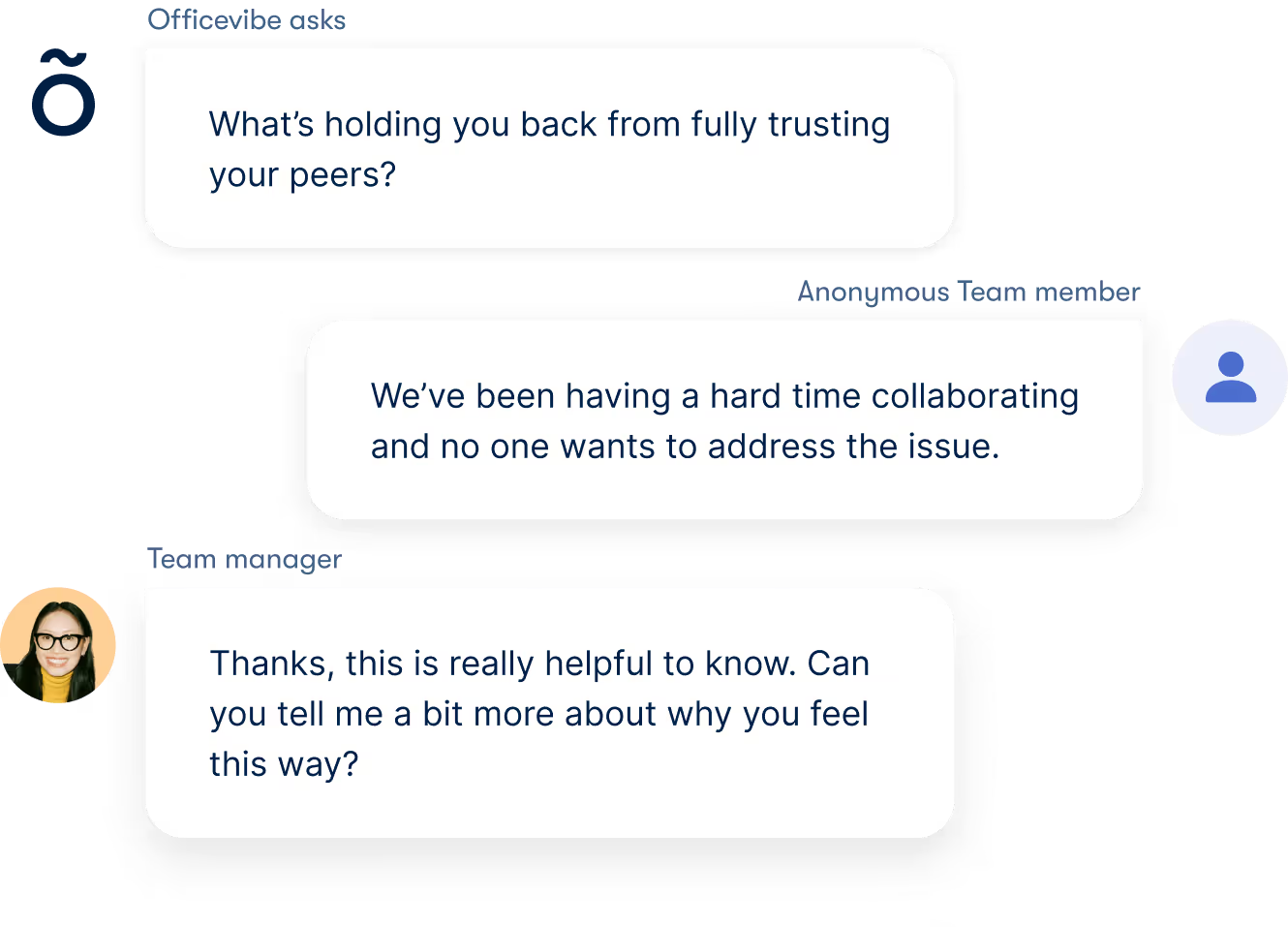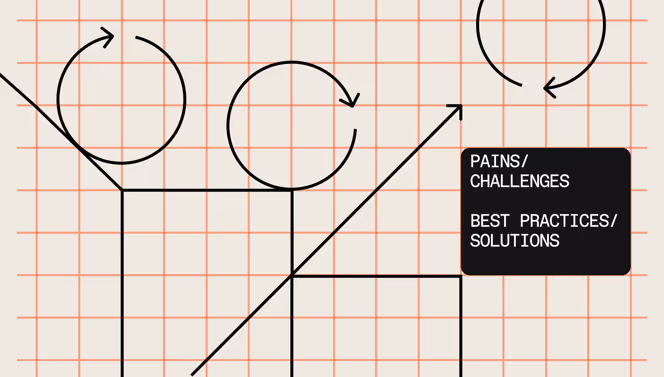What is real-time employee feedback?

Discover Workleap Officevibe's benchmark report on 12 key employee engagement metrics

Envision a team of highly-motivated, dedicated employees who regularly contribute fresh ideas that take your business to new heights. This picture might be a current reality or one you're working towards, and it's certainly one that can be maintained when you enter real-time employee feedback into your leadership mix.
Real-time feedback paves the way to build more engaged, productive teams. In this article, we'll dig into real-time employee feedback, break down the benefits, and show you how easy it is for it to work for you and your teams.
What is real-time feedback?
Real-time feedback is a performance management system that focuses on continuous improvement rather than evaluation. Real-time feedback isn’t the same as performance reviews, they supplement them by adding a constant communication cycle. The more immediate, actionable feedback helps employees grow and develop week by week.
When using this feedback process, you shift the emphasis from critical evaluation towards ongoing improvement. And it applies to everyone involved: manager and their people.
Employees get regular insights from their managers on what they are doing well and the areas where they can improve. And managers get insights into the employee experience and challenges where they can jump in to support. It all leads to a better employee experience and encourages progress and connection.
{highlight}
Compound employee growth
Interest compounded daily produces astounding results compared to interest compounded annually in the financial world. Similarly, real-time feedback greatly accelerates employee growth and leads to impressive, ongoing development.
In the fast-moving business world, you can’t afford to be one step behind. Using real-time employee feedback keeps you at the forefront of employee development, giving you a vital competitive advantage that makes a real difference on your bottom line.
{highlight}
Why real-time employee feedback is important
Employee feedback is very important in all of its forms. Real-time feedback is essential because it gives you a snapshot view of your team's pains and sentiments.
How are you supposed to celebrate accomplishments or provide guidance when met with challenges if you can't keep a pulse of what's happening on your team?
Establishing an environment that fosters real-time feedback with your team will help you lead confidently.
The need for real-time feedback is only becoming more necessary as we enter new ways of working. Real-time feedback can solve distributed or remote team challenges like feelings of disconnect among team members or decreased team oversight. By gathering of-the-moment insights on how your people are doing, and what they need to be happy in their roles, you can set the whole team up for success.
Real-time feedback is only effective if given often
The frequency of feedback has become a significant issue in the workplace. According to the latest Officevibe's Pulse Surveys, almost a quarter of employees are unsatisfied with the frequency of feedback from their manager. Worse still, 28% of employees report that feedback is too infrequent to help them improve.
That’s a major issue, but it’s only part of the problem. Team leaders, too, are concerned with improving performance management processes and delivering better employee feedback. They understand this is critical to creating a productive employee base.
Real-time feedback systems accelerate the pace of feedback. Everyone gets a chance to voice their concerns and make their feelings known on a regular basis.
Make the most of your team
By deploying a consistent feedback system, you can nip employee issues in the bud and promote greater harmony. The instant nature of this solution helps you head off problems and capitalize on individual strengths as they materialize.
Employee engagement will be enhanced, too. Everyone wants to feel heard, and real-time employee recognition encourages two-way communication to strengthen the team.
The result is more motivated employees who enjoy their work and are inspired to contribute as much as possible.
Now that’s the kind of improvement we’re looking for, right?
How to get real-time employee feedback
So the benefits of real-time feedback are clear. But how do you implement such a system in practice?
The good news is that implementing instant feedback is easier than you might expect. All you need are the right tools and procedures.
How to implement a real-time feedback system
Not so long ago, implementing real-time feedback was a formidable challenge for any organization. But thanks to innovative new software, it’s easy for any organization to implement an effective and productive system.
For example, Officevibe's employee feedback tool makes it simple to automate and organize how you collect feedback from employees.
{highlight}
Regardless of your team's size or location, you can use Pulse Surveys to give you insights into employee performance. You can also ask open-ended questions to probe deeper, while team members may share their real-time feedback anonymously.
{highlight}
The feedback tool does the hard work for you and integrates smoothly into everyone’s day-to-day. You can understand the employee experience instantly with user-friendly, straightforward reports and share survey results easily with your team.

What is the best way to get feedback from employees?
Having the right software is undoubtedly an important step, but it’s only part of the picture. You’ll see the real results when you also create an environment that encourages everyone to participate and make the most of the tools and opportunities.
The best way to encourage employees to give feedback begins with a feedback-positive culture in your team.
Everyone on the team needs to feel they can be candid about issues affecting them. They must also be open to receiving feedback, while managers should demonstrate that everyone has a voice that counts.
It’s OK for everyone on the team to be open and curious, and accepting negative feedback is important, too. There’s always a way to turn such insights into positive action that helps the whole team move forward.
{highlight}
Techniques for gathering feedback
Here’s a practical list of techniques you can use to gather feedback from your teams:
- New employee surveys: send new hires a survey during their first 30 days to assess their initial feelings about the company and their job
- Employee engagement surveys: collect a large amount of feedback, with the flexibility to cover everything from job satisfaction to retention
- Pulse surveys: a quick and easy way to poll opinions and find out what’s the mood across your organization (e.g. Officevibe’s Custom polls)
- Employee suggestion box: a tried and trusted way to collect ideas and bring issues to management’s attention
- Stay interviews: conduct interviews with happy, engaged employees who are staying put in their current jobs to understand what's behind their satisfaction.
- Team leaders: managers should have their finger on the pulse of what’s working and what’s not, so conntect with them to gain insight
- Exit interviews: departing employees are more likely to be honest about the root cause of their exit, so be sure to make the most of this unique oportunity
- Review sites: many people will be reluctant to share their job experience with their employers, but will tell their story on sites such as Glassdoor
{highlight}
Real-time feedback vs annual performance reviews
Real-time feedback is not intended to replace the traditional annual review but rather to enhance it. The two methods work hand-in-hand to produce exceptional outcomes for everyone.
While performance reviews meetings are common practice, they are far from perfect. A lot can happen and change in a year, especially for growing teams. Because of recency bias, annual reviews can focus on events within the last month or two. Significant projects from earlier in the year may be forgotten or given insufficient emphasis.
Real-time employee feedback fixes the problem by creating a continuous communications loop between employees and managers. Issues can be resolved as they arise instead of being kept quiet for up to a year.
Balanced performance feedback
Fortunately, real-time feedback systems capture key data throughout the year, giving both the manager and the employee a balanced view of the preceding 12 months. This helps the manager see the big picture and accurately assess the employee’s strengths and weaknesses.
Another advantage is that performance reviews can be conducted faster. Team leaders have all the information they need at their fingertips, making it easy to assess, summarize and provide appropriate feedback.
So when you combine the power of real-time feedback and annual performance reviews, you get a multi-dimensional perspective on the employee experience.
Real-time employee feedback loop
By now, you can undoubtedly see how such a system can transform employee relationships in your business.
But if you’re still on the fence, here’s another major advantage to consider: You will also create an incredible real-time employee feedback loop.

Employees receive ongoing feedback from managers, which they can use to improve. And in turn, can then offer their feedback to managers so that the organization can improve, too.
{highlight}
Over and over again, you will:
- Gather feedback
- Analyze the data
- Decide on improvements
- Implement changes
- Repeat!
{highlight}
A snowball of improvement
Can you see how powerful this loop is? You will be going way beyond regular performance management, creating a snowball of continuous improvement instead. Every circle around the loop makes your organization more efficient and productive than ever before.
You can implement the feedback loop on an informal basis or use an automated feedback tool. Or get creative with ideas like instating a ‘Feedback Friday’ routine that gives everyone a specific day of the week when they are encouraged to share their thoughts and opinions, whether good or bad.
Combine this with the power of real-time feedback software and you have an unstoppable improvement process.
What's the ideal real-time feedback frequency?
If you aim for continuous feedback, you’ll find that employee performances will soar. Regular feedback makes employees feel valued and enhances their motivation. When every team member will receive critical feedback quickly, you’re helping them to do better and more meaningful work.
With Officevibe, for example, you can send a Pulse Survey to your team on a regular basis—weekly, bi-weekly or monthly. You can experiment to find the frequency that is best for your organization. It’s always a good idea to discuss this with your team members and find out the best fit for them. That way, you’ll get a system optimal for all.
So it’s time to move away from thinking only about periodic performance reviews. Instead, focus on ensuring that employees, managers, and HR teams are always in the loop. We put together a number of employee feedback samples to help get you started!
Create a stronger team
Your employees are your most valuable asset, and it makes sense to take good care of them. Thanks to real-time feedback, performance management no longer has to be a top-down process that’s always behind the curve.
Instead, you can create a cutting-edge system that keeps your employees engaged and motivated. Your managers can share feedback with the team effectively while also benefiting from more input from employees.
The result is not just an improvement in each employee’s performance but a better learning experience for everyone.
Discover the power of real-time feedback
The best way to find out what real-time employee feedback can do is to try it yourself. You can begin with a small investment and minimal disruption to your regular routines. With the help of a tool like Officevibe, you will turn better employee communications into a competitive advantage.
Start for free today and you could see significant improvements within weeks. There’s no limit to what you can achieve with happier employees, more informed managers, and more productive teams.
Give HR and managers the clarity, confidence, and connection to lead better every day.


%20(1).avif)


.avif)
.avif)
.avif)







